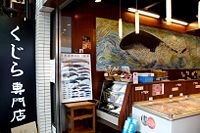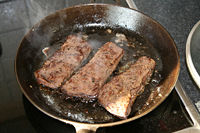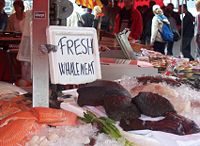Whale meat: Difference between revisions
imported>John Dvorak m (related articles already in cluster) |
imported>Stephen Ewen |
||
| (2 intermediate revisions by 2 users not shown) | |||
| Line 6: | Line 6: | ||
==Whale meat in Japan== | ==Whale meat in Japan== | ||
{{Image|Whale-shop.jpg|left|200px|Specialist shops sell whale meat in Japan. Look out for signs labelled '鯨肉' (''gei niku'' 'whale meat') or 'くじら' (''kujira'' 'whale').}} | |||
The Japanese have hunted whales since at least the eighth century, since the practice is mentioned in the ''Kojiki'' (古事記), Japan's oldest document, dating back to that time.<ref>''Beijing Review'': '[http://www.bjreview.com.cn/world/txt/2007-12/28/content_93184.htm A Whale of A Controversy]'. 28th December 2007.</ref><ref>''Japan Whaling Association'': '[http://www.whaling.jp/english/isana/no27_01.html Enjoying the Etymology of Whales]'. ''ISANA'' newsletter 27, July 2003.</ref><ref>''Japan Times'': '[http://search.japantimes.co.jp/cgi-bin/rc20080203a5.html Whaling dates back centuries]'. Letter to the editor, 3rd February 2008.</ref> Whale meat is considered a delicacy in Japan, and different regions prepare the meat in distinct ways; for example, in [[Kyushu]] it is served as fresh as possible, whereas northern diners prefer the meat to be flavoured through delaying freezing for a day or so after slaughter.<ref>''[[BBC]] News'': '[http://news.bbc.co.uk/2/hi/asia-pacific/7281989.stm Why Japan persists in hunting whales]'. 7th March 2008.</ref> It is available from specialist shops (signed 鯨 or くじら ''kujira'', 'whale'), or from some [[supermarket]]s, sometimes labelled 'whale [[pork|bacon]]'. It may also be thinly sliced as ''[[sashimi]]'' (刺身). | The Japanese have hunted whales since at least the eighth century, since the practice is mentioned in the ''Kojiki'' (古事記), Japan's oldest document, dating back to that time.<ref>''Beijing Review'': '[http://www.bjreview.com.cn/world/txt/2007-12/28/content_93184.htm A Whale of A Controversy]'. 28th December 2007.</ref><ref>''Japan Whaling Association'': '[http://www.whaling.jp/english/isana/no27_01.html Enjoying the Etymology of Whales]'. ''ISANA'' newsletter 27, July 2003.</ref><ref>''Japan Times'': '[http://search.japantimes.co.jp/cgi-bin/rc20080203a5.html Whaling dates back centuries]'. Letter to the editor, 3rd February 2008.</ref> Whale meat is considered a delicacy in Japan, and different regions prepare the meat in distinct ways; for example, in [[Kyushu]] it is served as fresh as possible, whereas northern diners prefer the meat to be flavoured through delaying freezing for a day or so after slaughter.<ref>''[[BBC]] News'': '[http://news.bbc.co.uk/2/hi/asia-pacific/7281989.stm Why Japan persists in hunting whales]'. 7th March 2008.</ref> It is available from specialist shops (signed 鯨 or くじら ''kujira'', 'whale'), or from some [[supermarket]]s, sometimes labelled 'whale [[pork|bacon]]'. It may also be thinly sliced as ''[[sashimi]]'' (刺身). | ||
{{Image|Pan fried whale meat.jpg|right|200px|Pan fried fresh whale meat steaks, seasoned with just salt and pepper.}} | |||
Whale meat was common in the nation's diet until the mid-twentieth century. However, there are signs that whale meat is becoming harder to find in Japan, with many shops no longer stocking it due to falling customer demand.<ref>''Japan Times'': '[http://search.japantimes.co.jp/cgi-bin/nn20080308a2.html Greenpeace: Stores, eateries less inclined to offer whale]'. 8th March 2008.</ref> In recent years, the government of Japan has encouraged people to eat more whale meat. School programmes have been set up to educate children on the life cycle of the meat, from the ocean to the dinner plate. Adult courses in preparing whale meat have also appeared. Total sponsorship by the government runs into millions of dollars annually.<ref>''[[Washington Post]]'': '[http://www.washingtonpost.com/wp-dyn/content/article/2005/06/18/AR2005061800890.html Reviving a Taste for Whale]'. 7th March 2008.</ref> | Whale meat was common in the nation's diet until the mid-twentieth century. However, there are signs that whale meat is becoming harder to find in Japan, with many shops no longer stocking it due to falling customer demand.<ref>''Japan Times'': '[http://search.japantimes.co.jp/cgi-bin/nn20080308a2.html Greenpeace: Stores, eateries less inclined to offer whale]'. 8th March 2008.</ref> In recent years, the government of Japan has encouraged people to eat more whale meat. School programmes have been set up to educate children on the life cycle of the meat, from the ocean to the dinner plate. Adult courses in preparing whale meat have also appeared. Total sponsorship by the government runs into millions of dollars annually.<ref>''[[Washington Post]]'': '[http://www.washingtonpost.com/wp-dyn/content/article/2005/06/18/AR2005061800890.html Reviving a Taste for Whale]'. 7th March 2008.</ref> | ||
==Whale meat in Norway== | ==Whale meat in Norway== | ||
{{Image|Fresh Whale Meat - Norway.jpg|left|200px|Fresh whale meat on sale in Norway.}} | |||
{{Image|Inupiak whale meat.jpg|right|200px|Meat from a [[Bowhead Whale]], hunted and eaten by [[Inupiaq]], [[Eskimos]], in [[Barrow, Alaska]]. It is legal in Alaska for Inupiak to harvest some whale.}} | |||
Norwegian markets supply whale meat, usually from [[minke whale]]s, in cities such as [[Bergen]]. Often the meat is smoked, but fresh whale meat is also available. [[English language|English]] signs are often placed to help buyers unfamiliar with [[Norwegian language|Norwegian]] to identify the meat amongst other produce. Whale steaks are popular in Norway, sometimes seasoned with parsley or red and green peppers, or just salt and pepper.<ref>For two recipes, see ''highnorth.no'': '[http://www.highnorth.no/library/Culture/Recipes/no-wh-me.htm Norwegian Whale Meat Recipes]'.</ref> | Norwegian markets supply whale meat, usually from [[minke whale]]s, in cities such as [[Bergen]]. Often the meat is smoked, but fresh whale meat is also available. [[English language|English]] signs are often placed to help buyers unfamiliar with [[Norwegian language|Norwegian]] to identify the meat amongst other produce. Whale steaks are popular in Norway, sometimes seasoned with parsley or red and green peppers, or just salt and pepper.<ref>For two recipes, see ''highnorth.no'': '[http://www.highnorth.no/library/Culture/Recipes/no-wh-me.htm Norwegian Whale Meat Recipes]'.</ref> | ||
==Footnotes== | ==Footnotes== | ||
{{reflist|2}} | {{reflist|2}} | ||
Revision as of 21:20, 18 October 2009
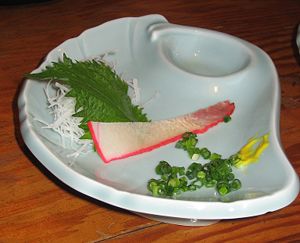
Whale meat is considered a delicacy in Japan. Here, the meat has been sliced into a strip of 'whale bacon'.
Whale meat refers to the edible flesh of various species of whale. It can be prepared and eaten in various ways, and for example forms one part of traditional Japanese cuisine (鯨肉 gei niku 'whale meat'). Servings also appear on menus in Norway and Iceland, where whales are also hunted, and also some Aboriginal communities take whales for their meat.
In recent years, however, concerns have been raised about the levels of pollutants in samples of whale meat,[1] and many people around the world object to the hunting and eating of whales and dolphins. In turn, pro-whaling representatives have argued that eating whale meat is more environmentally friendly than consuming meat raised from cattle.[2][3]
Whale meat in Japan
The Japanese have hunted whales since at least the eighth century, since the practice is mentioned in the Kojiki (古事記), Japan's oldest document, dating back to that time.[4][5][6] Whale meat is considered a delicacy in Japan, and different regions prepare the meat in distinct ways; for example, in Kyushu it is served as fresh as possible, whereas northern diners prefer the meat to be flavoured through delaying freezing for a day or so after slaughter.[7] It is available from specialist shops (signed 鯨 or くじら kujira, 'whale'), or from some supermarkets, sometimes labelled 'whale bacon'. It may also be thinly sliced as sashimi (刺身).
Whale meat was common in the nation's diet until the mid-twentieth century. However, there are signs that whale meat is becoming harder to find in Japan, with many shops no longer stocking it due to falling customer demand.[8] In recent years, the government of Japan has encouraged people to eat more whale meat. School programmes have been set up to educate children on the life cycle of the meat, from the ocean to the dinner plate. Adult courses in preparing whale meat have also appeared. Total sponsorship by the government runs into millions of dollars annually.[9]
Whale meat in Norway
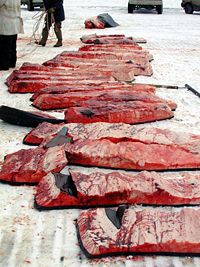
Meat from a Bowhead Whale, hunted and eaten by Inupiaq, Eskimos, in Barrow, Alaska. It is legal in Alaska for Inupiak to harvest some whale.
Norwegian markets supply whale meat, usually from minke whales, in cities such as Bergen. Often the meat is smoked, but fresh whale meat is also available. English signs are often placed to help buyers unfamiliar with Norwegian to identify the meat amongst other produce. Whale steaks are popular in Norway, sometimes seasoned with parsley or red and green peppers, or just salt and pepper.[10]
Footnotes
- ↑ New Scientist: 'Extreme mercury levels revealed in whalemeat'. 6th June 2002.
- ↑ High North Alliance: 'On the carbon footprint of whale meat'. March 2008. .doc file.
- ↑ Reuters UK: '"Eat whale and save the planet" says Norwegian lobby'. 4th March 2008.
- ↑ Beijing Review: 'A Whale of A Controversy'. 28th December 2007.
- ↑ Japan Whaling Association: 'Enjoying the Etymology of Whales'. ISANA newsletter 27, July 2003.
- ↑ Japan Times: 'Whaling dates back centuries'. Letter to the editor, 3rd February 2008.
- ↑ BBC News: 'Why Japan persists in hunting whales'. 7th March 2008.
- ↑ Japan Times: 'Greenpeace: Stores, eateries less inclined to offer whale'. 8th March 2008.
- ↑ Washington Post: 'Reviving a Taste for Whale'. 7th March 2008.
- ↑ For two recipes, see highnorth.no: 'Norwegian Whale Meat Recipes'.
